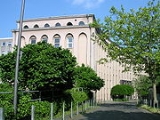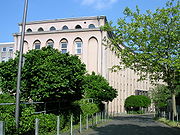
Walter Rogowski
Encyclopedia
Walter Rogowski was a German physicist who bridged the gap between theoretical physics and applied technology in numerous areas of electronics; the Rogowski coil
was named after him.
 In 1900, Rogowski began his studies at the RWTH Aachen
In 1900, Rogowski began his studies at the RWTH Aachen
, under Arnold Sommerfeld
, who occupied the Chair for Applied Mechanics. He acquired his Vordiplom
in 1902 and went on to study at the Danzig Technische Hochschule
, where he was also a scientific assistant. He completed his studies at Danzig in 1904, but stayed on until 1908, when he went to be a scientific assistant at the Physikalisch Technische Reichsanstalt in Berlin
, specializing in high current technology, telecommunications technology, and electrical physics
. After World War I
, Rogowski’s returned to Aachen, in 1920, and he became an ordinarius professor for theoretical electro-technology and director of the Institute for Electro-Technology. At that time, the institute was in the mining industry building. Rogowski, with his head assistant Eugen Flegler, began to put together a plan for their own building; the draft submission to the Ministry of Education was made by the university in 1923. However, the plan was not tackled until 1925, with inauguration of the generous institute building on October 27, 1929. The original plan proposed to house the entire electrical engineering section in the building. However, during the building phase, it was decided to only house Rogowski’s Institute in it. A main thrust of the institute was to bridge the gap between physics and electro-technology. Work carried out in the institute included general electro-technology, theoretical electro-technology, telecommunications technology, high frequency
engineering, electrical discharges
in gases, and high voltage
technology.
In 1927, the Norwegian Rolf Wideröe received his doctorate of engineering under Rogowski. Wideröe primarily worked on electrical particle accelerators. It was his 1927 paper in Archiv für Elektrotechnik that Ernest Lawrence
read in 1929, which gave him the idea for electrical resonance particle acceleration of protons, resulting in the cyclotron
.
Enst Sommerfeld, the son of Arnold Sommerfeld
, worked with Rogowski at his institute.
The institute was renamed in Rogowski’s honor and became the Rogowski-Institut der RWTH Aachen.
Rogowski coil
A Rogowski coil, named after Walter Rogowski, is an electrical device for measuring alternating current or high speed current pulses. It consists of a helical coil of wire with the lead from one end returning through the centre of the coil to the other end, so that both terminals are at the same...
was named after him.

RWTH Aachen
RWTH Aachen University is a research university located in Aachen, North Rhine-Westphalia, Germany with roughly 33,000 students enrolled in 101 study programs....
, under Arnold Sommerfeld
Arnold Sommerfeld
Arnold Johannes Wilhelm Sommerfeld was a German theoretical physicist who pioneered developments in atomic and quantum physics, and also educated and groomed a large number of students for the new era of theoretical physics...
, who occupied the Chair for Applied Mechanics. He acquired his Vordiplom
Diplom
A Diplom is an academic degree in the German-speaking countries Germany, Austria, and Switzerland and a similarly named degree in some other European countries including Belarus, Bosnia and Herzegovina, Croatia, Estonia, Finland , Greece, Hungary, Russia, Serbia, Macedonia, Slovenia, and Ukraine...
in 1902 and went on to study at the Danzig Technische Hochschule
Technische Hochschule
Technische Hochschule is what an Institute of Technology used to be called in German-speaking countries, as well as in the Netherlands, before most of them changed their name to Technische Universität or Technische Universiteit in the 1970s and in the...
, where he was also a scientific assistant. He completed his studies at Danzig in 1904, but stayed on until 1908, when he went to be a scientific assistant at the Physikalisch Technische Reichsanstalt in Berlin
Berlin
Berlin is the capital city of Germany and is one of the 16 states of Germany. With a population of 3.45 million people, Berlin is Germany's largest city. It is the second most populous city proper and the seventh most populous urban area in the European Union...
, specializing in high current technology, telecommunications technology, and electrical physics
Physics
Physics is a natural science that involves the study of matter and its motion through spacetime, along with related concepts such as energy and force. More broadly, it is the general analysis of nature, conducted in order to understand how the universe behaves.Physics is one of the oldest academic...
. After World War I
World War I
World War I , which was predominantly called the World War or the Great War from its occurrence until 1939, and the First World War or World War I thereafter, was a major war centred in Europe that began on 28 July 1914 and lasted until 11 November 1918...
, Rogowski’s returned to Aachen, in 1920, and he became an ordinarius professor for theoretical electro-technology and director of the Institute for Electro-Technology. At that time, the institute was in the mining industry building. Rogowski, with his head assistant Eugen Flegler, began to put together a plan for their own building; the draft submission to the Ministry of Education was made by the university in 1923. However, the plan was not tackled until 1925, with inauguration of the generous institute building on October 27, 1929. The original plan proposed to house the entire electrical engineering section in the building. However, during the building phase, it was decided to only house Rogowski’s Institute in it. A main thrust of the institute was to bridge the gap between physics and electro-technology. Work carried out in the institute included general electro-technology, theoretical electro-technology, telecommunications technology, high frequency
High frequency
High frequency radio frequencies are between 3 and 30 MHz. Also known as the decameter band or decameter wave as the wavelengths range from one to ten decameters . Frequencies immediately below HF are denoted Medium-frequency , and the next higher frequencies are known as Very high frequency...
engineering, electrical discharges
Electric discharge
Electric discharge describes any flow of electric charge through a gas, liquid or solid. Electric discharges include:*Electric glow discharge*Electric arc*Electrostatic discharge*Electric discharge in gases*Leader *Partial discharge...
in gases, and high voltage
High voltage
The term high voltage characterizes electrical circuits in which the voltage used is the cause of particular safety concerns and insulation requirements...
technology.
In 1927, the Norwegian Rolf Wideröe received his doctorate of engineering under Rogowski. Wideröe primarily worked on electrical particle accelerators. It was his 1927 paper in Archiv für Elektrotechnik that Ernest Lawrence
Ernest Lawrence
Ernest Orlando Lawrence was an American physicist and Nobel Laureate, known for his invention, utilization, and improvement of the cyclotron atom-smasher beginning in 1929, based on his studies of the works of Rolf Widerøe, and his later work in uranium-isotope separation for the Manhattan Project...
read in 1929, which gave him the idea for electrical resonance particle acceleration of protons, resulting in the cyclotron
Cyclotron
In technology, a cyclotron is a type of particle accelerator. In physics, the cyclotron frequency or gyrofrequency is the frequency of a charged particle moving perpendicularly to the direction of a uniform magnetic field, i.e. a magnetic field of constant magnitude and direction...
.
Enst Sommerfeld, the son of Arnold Sommerfeld
Arnold Sommerfeld
Arnold Johannes Wilhelm Sommerfeld was a German theoretical physicist who pioneered developments in atomic and quantum physics, and also educated and groomed a large number of students for the new era of theoretical physics...
, worked with Rogowski at his institute.
The institute was renamed in Rogowski’s honor and became the Rogowski-Institut der RWTH Aachen.

